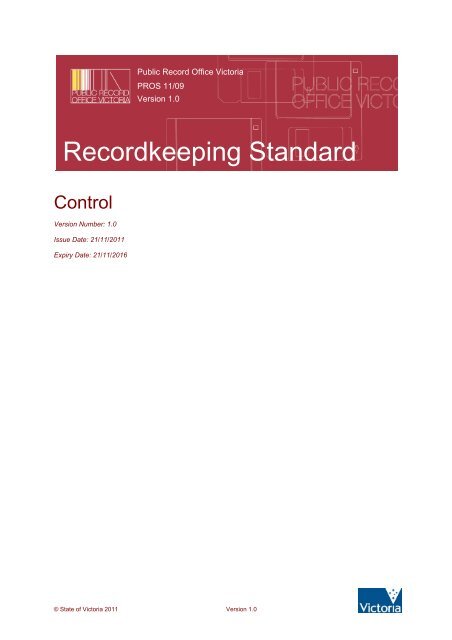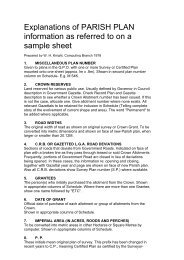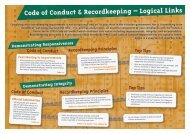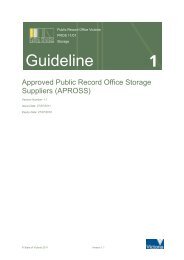Recordkeeping Standard - Public Record Office Victoria
Recordkeeping Standard - Public Record Office Victoria
Recordkeeping Standard - Public Record Office Victoria
You also want an ePaper? Increase the reach of your titles
YUMPU automatically turns print PDFs into web optimized ePapers that Google loves.
<strong>Public</strong> <strong>Record</strong> <strong>Office</strong> <strong>Victoria</strong><br />
PROS 11/09<br />
Version 1.0<br />
<strong><strong>Record</strong>keeping</strong> <strong>Standard</strong><br />
Control<br />
Version Number: 1.0<br />
Issue Date: 21/11/2011<br />
Expiry Date: 21/11/2016<br />
© State of <strong>Victoria</strong> 2011 Version 1.0
PROS 11/09: Control <strong>Standard</strong><br />
Establishment of <strong>Standard</strong><br />
Pursuant to Section 12 of the <strong>Public</strong> <strong>Record</strong>s Act 1973, I hereby establish these provisions<br />
as a <strong>Standard</strong> applying to all public records in <strong>Victoria</strong>. This <strong>Standard</strong> and its associated<br />
Specifications are mandatory for all <strong>Victoria</strong>n government agencies. This <strong>Standard</strong>, as varied<br />
or amended from time to time, shall have effect for a period of five (5) years from the date of<br />
issue unless revoked prior to that date.<br />
Justine Heazlewood<br />
Keeper of <strong>Public</strong> <strong>Record</strong>s Date of Issue: 21 November 2011<br />
© State of <strong>Victoria</strong> 2011 Version 1.0 Page 2 of 14
PROS 11/09: Control <strong>Standard</strong><br />
Table of Contents<br />
1. Introduction .....................................................................................................................4<br />
1.1. <strong>Public</strong> <strong>Record</strong> <strong>Office</strong> <strong>Victoria</strong> <strong>Standard</strong>s..................................................................4<br />
1.2. Purpose....................................................................................................................4<br />
1.3. Scope.......................................................................................................................5<br />
1.4. Definitions ................................................................................................................5<br />
1.5. Related Documents..................................................................................................8<br />
2. Detail of <strong>Standard</strong>............................................................................................................9<br />
2.1. Metadata ..................................................................................................................9<br />
2.2. Classification..........................................................................................................10<br />
2.3. Tracking .................................................................................................................11<br />
3. References .....................................................................................................................12<br />
Copyright Statement<br />
© State of <strong>Victoria</strong> 2011<br />
This work is copyright. Apart from any use as permitted under the Copyright Act 1968, no<br />
part may be reproduced through any process without prior written permission from the<br />
publisher. Enquiries should be directed to <strong>Public</strong> <strong>Record</strong> <strong>Office</strong> <strong>Victoria</strong>, PO Box 2100, North<br />
Melbourne, <strong>Victoria</strong> 3051 or email: agency.queries@prov.vic.gov.au.<br />
Disclaimer<br />
The State of <strong>Victoria</strong> gives no warranty that the information in this version is correct or<br />
complete, error free or contains no omissions. The State of <strong>Victoria</strong> shall not be liable for any<br />
loss howsoever caused whether due to negligence or otherwise arising from the use of this<br />
<strong>Standard</strong>.<br />
Acknowledgements<br />
The <strong>Public</strong> <strong>Record</strong> <strong>Office</strong> <strong>Victoria</strong> would like to acknowledge the valuable contribution of<br />
members of the Control Advisory Group during the development of this <strong>Standard</strong>.<br />
© State of <strong>Victoria</strong> 2011 Version 1.0 Page 3 of 14
PROS 11/09: Control <strong>Standard</strong><br />
1. Introduction<br />
1.1. <strong>Public</strong> <strong>Record</strong> <strong>Office</strong> <strong>Victoria</strong> <strong>Standard</strong>s<br />
Under section 12 of the <strong>Public</strong> <strong>Record</strong>s Act 1973, the Keeper of <strong>Public</strong> <strong>Record</strong>s (‘the<br />
Keeper’) is responsible for the establishment of <strong>Standard</strong>s for the efficient management of<br />
public records and for assisting <strong>Victoria</strong>n government agencies to apply those <strong>Standard</strong>s to<br />
records under their control.<br />
<strong><strong>Record</strong>keeping</strong> <strong>Standard</strong>s issued by <strong>Public</strong> <strong>Record</strong> <strong>Office</strong> <strong>Victoria</strong> (PROV) reflect best<br />
practice methodology. This includes International <strong>Standard</strong>s issued by the International<br />
Organisation for <strong>Standard</strong>isation (ISO) and Australian <strong>Standard</strong>s (AS) issued by <strong>Standard</strong>s<br />
Australia in addition to PROV’s research into current and future trends.<br />
Heads of government agencies are responsible under section 13b of the <strong>Public</strong> <strong>Record</strong>s Act<br />
1973 for carrying out, with the advice and assistance of the Keeper, a programme of efficient<br />
management of public records that is in accordance with all <strong>Standard</strong>s issued by the Keeper.<br />
In <strong>Victoria</strong>, a programme of records management is identified as consisting of the following<br />
components:<br />
• A recordkeeping framework;<br />
• <strong><strong>Record</strong>keeping</strong> procedures, processes and practices;<br />
• <strong>Record</strong>s management systems and structures;<br />
• People and organisational structures; and<br />
• Resources, including sufficient budget and facilities.<br />
A programme of records management needs to cover all agency records in all formats,<br />
media and systems, including business systems.<br />
1.2. Purpose<br />
This <strong>Standard</strong> provides a set of mandatory principles for <strong>Victoria</strong>n government agencies<br />
regarding recordkeeping controls for public records. This includes the required minimum<br />
metadata set to be connected with public records to enable their structure, context and<br />
history to be understood. It also covers classification and the tracking of actions, including<br />
movements and management of records.<br />
This <strong>Standard</strong> applies to recordkeeping controls regarding metadata, classification and<br />
tracking for all public records, regardless of format or media.<br />
The implementation of this <strong>Standard</strong> will provide the following benefits:<br />
• Justifiable evidence of the agency’s business can be provided, as records can be<br />
interpreted within the context of the business processes that resulted in their creation.<br />
• Effective records management practice occurs throughout the agency, as records<br />
management activities are triggered through classifying records.<br />
© State of <strong>Victoria</strong> 2011 Version 1.0 Page 4 of 14
PROS 11/09: Control <strong>Standard</strong><br />
• Queries are addressed more efficiently, as records can be quickly retrieved and<br />
accurately understood.<br />
1.3. Scope<br />
This <strong>Standard</strong> covers the high level principles relating to the function and activities of records<br />
control. Each principle consists of a statement of best practice, followed by an explanation of<br />
what is meant by the principle and why the principle is important.<br />
The principles detailed in this <strong>Standard</strong> provide the foundation for the measurable<br />
compliance requirements described in the associated Specification. Agencies must meet all<br />
the requirements detailed in the Specification to ensure they comply with the principles<br />
articulated in this <strong>Standard</strong>. Guidelines associated with this <strong>Standard</strong> will assist agencies to<br />
implement these requirements.<br />
Please note that principles for controls regarding access and security are located within the<br />
Access <strong>Standard</strong>.<br />
1.4. Definitions<br />
The following terms are the major terms of relevance for this <strong>Standard</strong>. For a full list of<br />
records management and PROV terminology, see the Master Glossary.<br />
Action: ‘The process or condition of acting or doing, the exertion of energy or influence’. 1<br />
Agency: See Government Agency.<br />
Aligned: A parallel or coordinated arrangement or approach.<br />
Beneficial Ownership: Beneficial ownership is enjoyed by anyone who has the benefits of<br />
ownership of an asset, and yet does not nominally own the asset.<br />
Business <strong>Record</strong>s: A public record that relates to the business of the agency and must be<br />
managed as evidence of business decision and transactions. This excludes ephemeral<br />
records and records of business that are not beneficially owned by the agency.<br />
Business Classification: See Classification.<br />
Classification: ‘Systematic identification and arrangement of business activities and / or<br />
records into categories according to logically structured conventions, methods, and<br />
procedural rules represented in a classification system.’ 2<br />
Context: ’The knowledge necessary to sustain a record’s meaning or evidential value.<br />
Context describes the who, what, where and why of record creation and use.’ 3<br />
Continuous Improvement: ‘The process of establishing objectives and finding opportunities<br />
for improvement is a continuous process through the use of audit findings, audit conclusions,<br />
1 CT Onions, The Shorter Oxford English Dictionary on Historical Principles, Volume 1: A to Markworthy, Oxford<br />
University Press, Oxford England, 1973 p. 20.<br />
2 <strong>Standard</strong>s Australia, AS ISO 15489:1 Australian standard on records management: Part 1: General, <strong>Standard</strong>s<br />
Australia, Sydney, 2002, ss. 3.5, p. 2.<br />
3 <strong>Standard</strong>s Australia, HB 5031:2011 <strong>Record</strong>s Classification Handbook, <strong>Standard</strong>s Australia, Sydney, 2011, s.9,<br />
p. 39.<br />
© State of <strong>Victoria</strong> 2011 Version 1.0 Page 5 of 14
PROS 11/09: Control <strong>Standard</strong><br />
analysis of data, management reviews, or other means and generally leads to corrective<br />
action or preventative action.’ 4<br />
Custodian: A person, business unit or agency that has custody.<br />
Custody: Responsibility for the care of records and archives, usually based on their physical<br />
possession. Custody does not necessarily include legal ownership.<br />
Disposal: A range of processes associated with implementing appraisal decisions which are<br />
documented in disposal authorities or other instruments. These include the retention,<br />
destruction or deletion of records in or from recordkeeping systems. They may also include<br />
the migration or transmission of records between recordkeeping systems, the transfer of<br />
ownership or the transfer of custody of records, e.g. to <strong>Public</strong> <strong>Record</strong> <strong>Office</strong> <strong>Victoria</strong>. 5<br />
Document: See <strong>Public</strong> <strong>Record</strong>.<br />
Ephemeral <strong>Record</strong>s: Working papers, drafts and copies of public records that do not need<br />
to be retained for business purposes and which may be disposed of under Normal<br />
Administrative Practice (NAP).<br />
Executive / Senior Executive: ‘A person [or people] employed under Part 3 [of the <strong>Public</strong><br />
Administration Act 2004] as a public service body Head or other executive;’6 or Senior<br />
<strong>Office</strong>r as described by the Local Government Act 1989. 7<br />
Government Agency: Any department, agency or office of the Government of <strong>Victoria</strong>. 8 It<br />
includes:<br />
• any department branch or office of the government of <strong>Victoria</strong>;<br />
• any public statutory body corporate or unincorporate;<br />
• a State owned enterprise within the meaning of the State Owned Enterprises Act 1992;<br />
• any municipal council;<br />
• any other local governing body corporate or unincorporated; and<br />
• any <strong>Victoria</strong>n court or person acting judicially.<br />
Head of a Government Agency: The head of a department, administrative office, public<br />
sector body, public service body, small entity, or standard entity as described by the <strong>Public</strong><br />
Administration Act 2004 9 or the Chief Executive <strong>Office</strong>r as described by the Local<br />
Government Act 1989. 10<br />
Keeper of <strong>Public</strong> <strong>Record</strong>s: The Keeper is the Director of <strong>Public</strong> <strong>Record</strong> <strong>Office</strong> <strong>Victoria</strong>. The<br />
Keeper of <strong>Public</strong> <strong>Record</strong>s (‘the Keeper’) is responsible for the establishment of <strong>Standard</strong>s for<br />
the efficient management of public records and for assisting agencies to apply those<br />
<strong>Standard</strong>s to records under their control. 11<br />
4 <strong>Standard</strong>s Australia, AS/NZS ISO 9000:2006 Australian/New Zealand standard on quality management systems<br />
– Fundamentals and vocabulary, <strong>Standard</strong>s Australia, Sydney, 2006, ss. 3.2.13 (note), p. 9.<br />
5 AS ISO 15489:1, ss. 3.9, p. 3.<br />
6 <strong>Public</strong> Administration Act 2004, s. 23.<br />
7 Local Government Act 1989, s. 3.<br />
8 <strong>Public</strong> <strong>Record</strong>s Act 1973, s. 2.<br />
9 <strong>Public</strong> Administration Act 2004, s. 4.<br />
10 Local Government Act 1989, s. 3.<br />
11 <strong>Public</strong> <strong>Record</strong>s Act 1973, ss. 6-7.<br />
© State of <strong>Victoria</strong> 2011 Version 1.0 Page 6 of 14
PROS 11/09: Control <strong>Standard</strong><br />
Location: ‘A particular place.’ 12<br />
individuals.<br />
This may be geographical, virtual, or relate to specific<br />
Mapped: Diagrammatic or graphic representation that explicitly links two concepts and can<br />
therefore be used to illustrate relationships. Examples of mapping methods include<br />
ontological engineering, OBASHI method, crosswalks mapping, workflow diagrams and<br />
relationship diagrams.<br />
Metadata: ‘Data describing context, content and structure of records and their management<br />
through time’. 13 Metadata is not format based and can be recorded on various media<br />
including on hardcopy documents, in related databases and in electronic systems.<br />
Movement: Change of location. This includes a change of location from one system to<br />
another, from one storage location to another, from one user to another, from one agency to<br />
another, or one business unit to another.<br />
Normal Administrative Practice (NAP): The destruction of some public records is permitted<br />
under normal administrative practice (NAP). NAP covers the destruction of ephemeral<br />
material of a facilitative or duplicate nature created, acquired or collected by public sector<br />
employees during the course of their duties.<br />
<strong>Office</strong>r in Charge of a <strong>Public</strong> <strong>Office</strong>: See Head of Government Agency.<br />
Personal <strong>Record</strong>s: <strong>Record</strong>s that are of a personal nature and have no relevance to the<br />
business of the agency.<br />
<strong>Public</strong> <strong>Office</strong>: See Government Agency.<br />
<strong>Public</strong> <strong>Office</strong>r: See <strong>Public</strong> Sector Employee.<br />
<strong>Public</strong> <strong>Record</strong>:<br />
(a) any record made or received by a public officer in the course of his duties; and<br />
(b) any record made or received by a court or person acting judicially in <strong>Victoria</strong>—<br />
but does not include—<br />
(c) a record which is beneficially owned by a person or body other than the Crown or a<br />
public office or a person or body referred to in s. 2B [of the <strong>Public</strong> <strong>Record</strong>s Act 1973];<br />
or<br />
(d) a prescribed record held for the purpose of preservation by a public office to which it<br />
was transferred before the commencement of the Arts Institutions (Amendment) Act<br />
1994 by a person or body other than the Crown or a public office; or<br />
(e) a record, other than a prescribed record, held for the purpose of preservation by a<br />
public office to which it was transferred, whether before or after the commencement of<br />
the Arts Institutions (Amendment) Act 1994, by a person or body other than the Crown<br />
or a public office. 14<br />
<strong>Public</strong> records may be divided into business records, ephemeral records and personal<br />
records.<br />
12 JB Sykes, The Concise Oxford Dictionary of Current English sixth edition, Oxford University Press, London, UK,<br />
1976, p. 638.<br />
13 AS ISO 15489:1, ss. 3.12, p. 3.<br />
14 <strong>Public</strong> <strong>Record</strong>s Act 1973, s. 2.<br />
© State of <strong>Victoria</strong> 2011 Version 1.0 Page 7 of 14
PROS 11/09: Control <strong>Standard</strong><br />
<strong>Public</strong> Sector Employee: Any person employed in a government agency or who performs<br />
work over which an agency has, or should have, direct control and for which an agency has<br />
direct liability. It is derived from 'public officer’ in s. 2 of the <strong>Public</strong> <strong>Record</strong>s Act 1973.<br />
Senior <strong>Office</strong>r: A person or committee with managerial responsibility.<br />
Structure: The ‘format and relationships between the elements comprising the record.’ 15<br />
System: ‘Information system which captures, manages and provides access to records<br />
through time.’ 16 A system may be manual or automated and includes the processes,<br />
procedures and business rules required to operate it.<br />
Tracking: ‘Creating, capturing and maintaining information about the movement and use of<br />
records.’ 17<br />
1.5. Related Documents<br />
The Specifications and Guidelines directly associated with this <strong>Standard</strong> are detailed below.<br />
Other PROV <strong>Standard</strong>s and Specifications, including Retention & Disposal Authorities<br />
(RDAs), will also affect how this <strong>Standard</strong> is implemented in particular agencies.<br />
Figure 1: Relationship Diagram<br />
15 AS ISO 15489:1, ss. 7.2.1, p. 7.<br />
16 AS ISO 15489:1, ss. 3.17, p. 3.<br />
17 AS ISO 15489:1, ss. 3.19, p. 3.<br />
© State of <strong>Victoria</strong> 2011 Version 1.0 Page 8 of 14
PROS 11/09: Control <strong>Standard</strong><br />
2. Detail of <strong>Standard</strong><br />
2.1. Metadata<br />
Principle: Metadata elements needed for the structure, context and management of business<br />
records to be used and understood over time are captured, maintained and connected with<br />
the records.<br />
The intent of this principle is to ensure that business records are connected with the<br />
information necessary for them to be clearly understood and interpreted over time. Metadata<br />
is captured and connected with a record at point of creation or capture and at various<br />
additional points during the retention period. This includes metadata elements regarding the<br />
business processes in which the record was used, the context of the management of the<br />
record and structural changes to the record (including its appearance).<br />
Metadata is captured and connected with all business records, regardless of their format.<br />
Different methods of connecting metadata to records may be used. For example, digital<br />
records could be connected with metadata in accordance with the <strong>Victoria</strong>n Electronic<br />
<strong>Record</strong>s Strategy (VERS) <strong>Standard</strong>. Hardcopy records could use classification schemes, file<br />
covers, registers, databases and other records management tools to connect the metadata<br />
with the records.<br />
The metadata captured and connected with records have multiple aspects that coexist<br />
depending on how the metadata was intended to be used. For example, metadata can<br />
support business processes, reflect the management of the record over time and be used to<br />
enable the record to be retrieved and interpreted more easily.<br />
The different aspects, and the specific metadata elements required for their support, have to<br />
be considered when determining the metadata the agency will need to connect with their<br />
business records. The type and amount of metadata connected with a record will be limited<br />
by the boundaries of specific records, business and information systems.<br />
The benefits of connecting metadata with business records are as follows:<br />
• Evidential integrity of business records can be demonstrated and justified when their<br />
validity is questioned.<br />
• Business records can be interpreted within the context of their business process as<br />
well as the actions upon the records so their full story is known and can be explained to<br />
others.<br />
• Data exchange or data transfer protocols are efficiently implemented as metadata is<br />
documented, retrievable and accurate.<br />
• <strong>Record</strong>s management processes, such as disposal sentences, access controls, and<br />
classification schemes, can be directly associated with the records from the point of<br />
capture to enable more efficient recordkeeping practice.<br />
• Relationships between records, and with business processes, are explicit and can be<br />
clearly demonstrated over time.<br />
The minimum requirements to comply with this control principle, including the required<br />
minimum metadata set, are detailed in the Specification issued under this <strong>Standard</strong>.<br />
© State of <strong>Victoria</strong> 2011 Version 1.0 Page 9 of 14
PROS 11/09: Control <strong>Standard</strong><br />
2.2. Classification<br />
Principle: Business records are classified in accordance with business classification<br />
schemes that are aligned and mapped to access controls and disposal programmes.<br />
The intent of this principle is to ensure that business records are clearly placed within their<br />
business contexts so they may be understood, identified, accessed, reused and managed<br />
appropriately. This is achieved through aligning schemes with business processes and<br />
workflows as well as mapping schemes to records management actions including access<br />
and disposal.<br />
Classification, or the act of arranging records in a logical structure and sequence, facilitates<br />
their subsequent use and reference. It also enables appropriate linking, grouping, naming,<br />
security, user permissions and retrieval, disposition and identification of vital records.<br />
Classification may be functional, process based, subject based or organisation based.<br />
Business classification schemes are an output of an analysis of business activities, such as<br />
work process analysis. They provide an understanding of the relationship between the<br />
agency’s business and its records. The agency will need to determine the degree of<br />
classification control they require for their business purposes.<br />
<strong>Record</strong>s are usually classified at the file level using classification schemes that are<br />
supported by controls appropriate for the records management environment of the agency.<br />
The title of the file reflects the business function and activity that is being documented. The<br />
title should use terms that are defined in classification tools, such as thesauri, business<br />
classification schemes or authorised headings lists. Using controlled language when titling<br />
and classifying and indexing records helps them to be identified and retrieved more easily.<br />
There may be instances where multiple classification schemes are needed in an agency. For<br />
example, different business systems may not be able to have the same classification terms<br />
due to systems limitations. In such instances, the different terms will need to be aligned with<br />
the main business classification scheme so that the correct terms for use in the various<br />
circumstances are clear. Mapping the classification scheme to the retention and disposal<br />
authority classes will enable sentencing to be carried out as part of the classification process.<br />
Mapping the classification scheme to access and security controls will enable such controls<br />
to be integral to the classification process.<br />
The benefits of arranging records in accordance with classification schemes that are mapped<br />
and aligned with records management controls are as follows:<br />
• Business practice is more efficient as records are consistently arranged in accordance<br />
with their business function and activity and can therefore be easily located when<br />
information on that activity or function is required.<br />
• <strong>Record</strong>s management practice is more effective as mapping classification schemes to<br />
records management tools, such as retention and disposal authorities, enables<br />
recordkeeping controls to be assigned when records are classified.<br />
• A continuous record of the agency’s business can be demonstrated as classification<br />
provides clear linkages between records and the business processes that produced<br />
them.<br />
• The need to reorganise record classification after an organisational restructure is<br />
reduced as the functions and activities that a business classification scheme is based<br />
on will probably remain the same.<br />
• Classifying records by function and activity enables transfer of records between<br />
agencies to be conducted more efficiently.<br />
© State of <strong>Victoria</strong> 2011 Version 1.0 Page 10 of 14
PROS 11/09: Control <strong>Standard</strong><br />
The minimum requirements to comply with this control principle are detailed in the<br />
Specification issued under this <strong>Standard</strong>.<br />
2.3. Tracking<br />
Principle: Business records are accurately tracked using systems that create, capture and<br />
maintain information about the movement of and actions on records.<br />
The intent of this principle is to ensure that systems are in place to enable the agency to<br />
know where their business records are and what actions are taking place upon them over<br />
time.<br />
Tracking the actions related to a record enables the agency to identify the history of actions<br />
upon the record. Actions related to the record or its use may include who did what when in<br />
relation to what specific business process, or as a response to which specific decision or<br />
transaction.<br />
Systems (whether automated or manual) can be used to accurately track the movement and<br />
history of a business record. This includes information regarding the date and time of the<br />
movement, the physical location of the record, who has custody of the record, how and why<br />
the record was moved and what actions have taken place upon the record.<br />
The benefits of having in place systems that track and document the movements and actions<br />
related to business records are as follows:<br />
• Tracking the movements of business records enhances identification and retrieval and<br />
enables queries to be addressed efficiently as the location of business records can be<br />
established quickly and accurately.<br />
• Tracking actions related to business records enables the evidential value of business<br />
records to be maintained as questions regarding past actions and why they occurred<br />
can be determined and answered.<br />
• Tracking records supports information security as the details of the movement, history<br />
and custodianship are captured and maintained.<br />
The minimum requirements to comply with this control principle are detailed in the<br />
Specification issued under this <strong>Standard</strong>.<br />
© State of <strong>Victoria</strong> 2011 Version 1.0 Page 11 of 14
PROS 11/09: Control <strong>Standard</strong><br />
3. References<br />
National Archives of Australia (NAA) 2003, Overview of Classification Tools for <strong>Record</strong>s<br />
Management, NAA, Canberra, viewed 18 March 2011,<br />
.<br />
Onions, CT, 1986, The Shorter Oxford English Dictionary on Historical Principles, Volume 1:<br />
A to Markworthy, 3 rd Edition, Oxford University Press, Oxford, UK.<br />
<strong>Standard</strong>s Australia International (SAI) 2011, HB 5031 <strong>Record</strong>s Classification Handbook,<br />
SAI, Sydney.<br />
State <strong>Record</strong>s Authority of New South Wales (SRANSW) 1993, revised 2004, File Format: A<br />
Guide to the Physical Design and Construction of Files, SRANSW, Sydney, viewed 21 March<br />
2011, .<br />
State <strong>Record</strong>s Authority of New South Wales (SRANSW) 2005, <strong><strong>Record</strong>keeping</strong> in Brief: 42:<br />
Checklist for Assessing Business Systems, SRANSW, Sydney, viewed 21 March 2011,<br />
.<br />
State <strong>Record</strong>s Authority of New South Wales (SRANSW) 2010, <strong><strong>Record</strong>keeping</strong> in Brief 57:<br />
Managing Shared Drives, SRANSW, Sydney, viewed 21 March 2011,<br />
.<br />
State <strong>Record</strong>s of South Australia (SRSA) 2002, Developing a Thesaurus: Guideline, SRSA,<br />
Adelaide, viewed 21 March 2011,<br />
.<br />
State <strong>Record</strong>s of South Australia (SRSA) 2009, Adequate <strong>Record</strong>s Management in<br />
Perspective: Classifying Official <strong>Record</strong>s, SRSA, Adelaide, viewed 21 March 2011,<br />
.<br />
State <strong>Record</strong>s of South Australia (SRSA) 2009, <strong><strong>Record</strong>keeping</strong> Metadata, SRSA, Adelaide,<br />
viewed 21 March 2011,<br />
.<br />
Sykes, JB, 1976, The Concise Oxford Dictionary of Current English 6 th Edition, Oxford<br />
University Press, London, UK.<br />
<strong>Victoria</strong>n Auditor General’s <strong>Office</strong> (VAGO) 2008, Report on <strong>Record</strong>s Management in the<br />
<strong>Victoria</strong>n <strong>Public</strong> Sector, VAGO, Melbourne, viewed 21 January 2011,<br />
.<br />
<strong>Victoria</strong>n Auditor General’s <strong>Office</strong> (VAGO) 2008, <strong>Record</strong>s Management Checklist, VAGO<br />
Melbourne, viewed 21 January 2011,<br />
.<br />
© State of <strong>Victoria</strong> 2011 Version 1.0 Page 12 of 14
PROS 11/09: Control <strong>Standard</strong><br />
Legislation<br />
Crimes Act 1958 (Vic)<br />
Evidence Act 2008 (Vic)<br />
Freedom of Information Act 1982 (Vic)<br />
Health <strong>Record</strong>s Act 2001 (Vic)<br />
Information Privacy Act 2000 (Vic)<br />
Local Government Act 1989 (Vic)<br />
Occupational Health and Safety Act 2004 (Vic)<br />
<strong>Public</strong> Administration Act 2004 (Vic)<br />
<strong>Public</strong> <strong>Record</strong>s Act 1973 (Vic)<br />
All current <strong>Victoria</strong>n legislation is available at http://www.legislation.vic.gov.au.<br />
<strong>Standard</strong>s<br />
Archives New Zealand (ANZ) 2008, Create and maintain recordkeeping standard S7, ANZ,<br />
Wellington, viewed 18 March 2011, .<br />
Archives New Zealand (ANZ) 2008, Electronic <strong><strong>Record</strong>keeping</strong> Metadata <strong>Standard</strong> S8, ANZ,<br />
Wellington, viewed 18 March 2011, .<br />
National Archives of Australia (NAA) 2008, Australian Government <strong><strong>Record</strong>keeping</strong> Metadata<br />
<strong>Standard</strong>, NAA, Canberra, viewed 18 March 2011,<br />
.<br />
<strong>Public</strong> <strong>Record</strong> <strong>Office</strong> <strong>Victoria</strong> (PROV) 2003, PROS 99/007 v2.1 Specification 2: VERS<br />
Metadata Scheme, PROV, North Melbourne, viewed 17 May 2011,<br />
.<br />
<strong>Public</strong> <strong>Record</strong> <strong>Office</strong> <strong>Victoria</strong> (PROV) 2003, Advice 11: Advice on VERS Metadata Scheme<br />
PROS 99/007 v2.0 Specification 2, PROV, North Melbourne, viewed 17 May 2011,<br />
.<br />
Queensland State Archives (QSA) 2009, Information <strong>Standard</strong> IS40: <strong><strong>Record</strong>keeping</strong>, QSA,<br />
Brisbane, viewed 18 March 2011,<br />
.<br />
<strong>Standard</strong>s Australia International (SAI) 2002, AS ISO 15489.1 Australian <strong>Standard</strong>: <strong>Record</strong>s<br />
Management Part 1: General, SAI, Sydney.<br />
<strong>Standard</strong>s Australia International (SAI) 2002, AS ISO 15489.2 Australian <strong>Standard</strong>: <strong>Record</strong>s<br />
Management Part 2: Guidelines, SAI, Sydney.<br />
<strong>Standard</strong>s Australia International (SAI) 2003, AS 5090 Australian <strong>Standard</strong>: Work Process<br />
Analysis for <strong><strong>Record</strong>keeping</strong>, SAI, Sydney.<br />
© State of <strong>Victoria</strong> 2011 Version 1.0 Page 13 of 14
PROS 11/09: Control <strong>Standard</strong><br />
<strong>Standard</strong>s Australia International (SAI) 2004, AS ISO 23081.1 Australian <strong>Standard</strong>:<br />
Information and Documentation: <strong>Record</strong>s Management Processes: Metadata for <strong>Record</strong>s:<br />
Part 1: Principles, SAI, Sydney.<br />
<strong>Standard</strong>s Australia International (SAI) & <strong>Standard</strong>s New Zealand 2007, AS/NZS ISO<br />
23081.2 Australian / New Zealand <strong>Standard</strong>: Information and Documentation: <strong>Record</strong>s<br />
Management Processes: Metadata for records: Part 2: Conceptual and implementation<br />
issues, SAI, Sydney.<br />
State <strong>Record</strong>s Authority of New South Wales (SRANSW) 2008, <strong>Standard</strong> on Digital<br />
<strong><strong>Record</strong>keeping</strong>: <strong>Standard</strong> No 10, SRANSW, Kingswood, viewed 18 March 2011,<br />
.<br />
State <strong>Record</strong>s of South Australia (SRSA) 2008, Adequate <strong>Record</strong>s Management <strong>Standard</strong>,<br />
SRSA, Adelaide, viewed 21 March 2011,<br />
.<br />
State <strong>Record</strong>s of South Australia (SRSA) 2009, South Australian <strong><strong>Record</strong>keeping</strong> Metadata,<br />
SRSA, Adelaide, viewed 21 March 2011,<br />
.<br />
State <strong>Record</strong>s of South Australia (SRSA) 2009, EDRMS Design <strong>Standard</strong>, SRSA, Adelaide,<br />
viewed 21 March 2011,<br />
.<br />
Other Resources<br />
For more information about the control of public records, please contact:<br />
Government Services<br />
<strong>Public</strong> <strong>Record</strong> <strong>Office</strong> <strong>Victoria</strong><br />
Ph: (03) 9348 5600<br />
Fax: (03) 9348 5656<br />
Email: agency.queries@prov.vic.gov.au<br />
Web: www.prov.vic.gov.au<br />
© State of <strong>Victoria</strong> 2011 Version 1.0 Page 14 of 14









